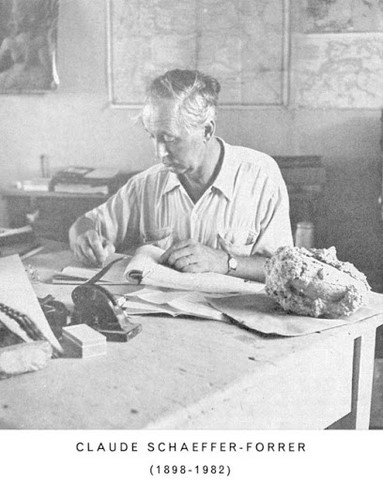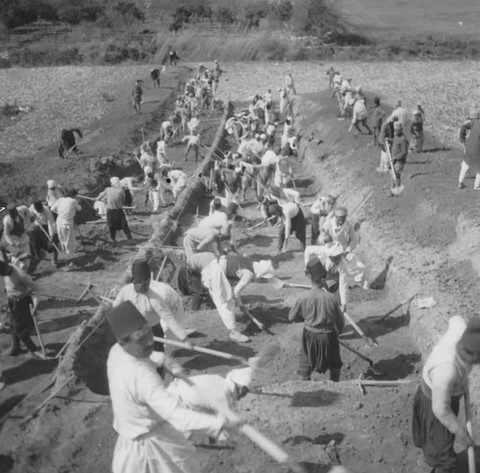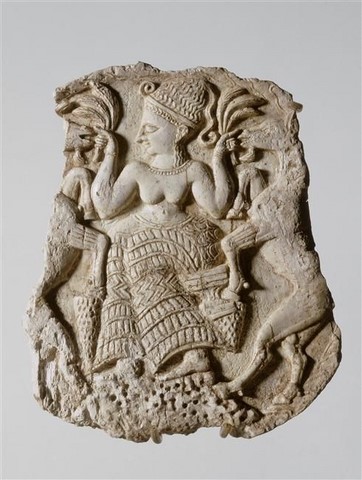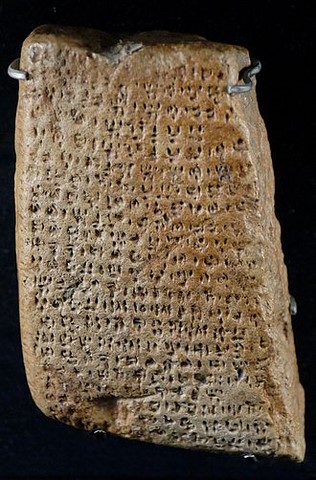Reading from Claude Schaeffer's Stratigraphie Comparée...

Large excerpts from Claude Schaeffer's legendary opus: Stratigraphie Comparée et Chronologie de l'Asie Occidentale (III et II. Millénaires), published in 1948 by Oxford University Press, will now be readable on Q-MAG.org in a translation from the French by Anne-Marie de Grazia. Claude Schaeffer compared the stratigraphy of a vast number of archaeological sites in the Near East and beyond ("Syria, Palestine, Asia Minor, Cyprus, Persia, Caucasus") and painstakingly made out the signs of five successive, large natural catastrophes which seemed to have affected all the sites simultaneously during the 3rd and 2nd millennia BC..
Alfred de Grazia and I had the great pleasure of,visiting Claude Schaeffer and his wife, Odile (my Alsatian compatriots) at their home in St Germain-en-Laye, near Paris, in February 1978. An unforgettable occasion.
Anne-Marie de Grazia, Aug. 1, 2020
Go to: Claude Schaeffer's Comparative Stratigraphy and Chronology of Western Asia (III & II Millennia)
Claude Schaeffer - The Discoverer of Ugarit
by the Center of Online Judaic Studies
The death of Claude Schaeffer of cancer on August 25, 1982 at the age of 84 in his home at St Germain-en-Laye marked the end of an epoch in the archaeology of the Near East. He was the last of those titanic figures whose achievements are sometimes hard for us to appreciate from our modern situation.
The excavation of Ugarit, with which Schaeffer’s name will always be linked, began at a site known as Minet el-Beida, the “White Harbor,” on the eastern coast of the Mediterranean Sea north of Beirut, now in Syria. From antiquity to the present, the site has been an important seaport (it currently serves as a Russian base). In 1929, when Schaeffer first came there, the area was inhabited mainly by the Alaouite tribe, which claimed descent from a nephew of the prophet Mohammed. The Alaouites were considered even by Moslems to be a hostile and secret religious minority. In 1920, the Allies had created a “Territory of the Alaouites,” which had been approved by the League of Nations. In 1924, the encompassing “Syrian Federation” was dissolved, and hence the area became an independent “State of the Alaouites.” That was the situation when Schaeffer first arrived.
In the spring of 1928, an Alaouite peasant had plowed up a flagstone that exposed a burial chamber, which had promptly been rifled. Inasmuch as Alaouite men only supervised, rather than performed, work, which was actually done by their wives (limited by their religion to seven), the credit for this initial archaeological discovery should perhaps go to a woman. The governor of the Alaouites, H. Schoeffler, notified the Bureau of Antiquities in Beirut, whose head, Charles Virolleaud, cleared the tomb. In Paris he showed the potsherds he had found to René Dussaud (to whom Ugaritica V was dedicated forty years later). On the basis of these sherds and a drawing of the tomb, Dussaud found significant parallels with Mycenaean ware and Cretan tombs.
The Académie des Inscriptions et Belles-Lettres in Paris decided to send an archaeological expedition to the site. To head the expedition, it chose the 30-year-old curator of the Prehistoric and Gallo-Roman Museum of Strasbourg, Claude Schaeffer. Schaeffer had had no previous experience in Near Eastern archaeology. Many no doubt found it a strange choice. He was to be assisted by a close friend, Georges Chenet, whose tragic early death terminated what would in all likelihood have been a lifelong collaboration. The selection of Schaeffer, however, turned out to be one of the most important decisions ever made in Biblical archaeology.
In those days, one reached the end of civilization at Tripoli, north of Beirut. Further north, the area was infested by so-called Hashishin, “those who are addicted to hashish.” From Hashishin we also get the English word assassin.
The French had built a road as far north as Latakia, the “capital” of the Alaouite State. The fledgling expedition led by Schaeffer tried to press beyond Latakia, overconfident in their American cars. In the end, they had to turn back and start again with camels instead of cars. They were accompanied by a few natives on horseback as guards.
On arriving at Minet el-Beida, Selim, the caravan guide, unloaded the camels on the nearest dune, collected his pay in Turkish silver coins (not trusting Syrian paper money), and disappeared. Schaeffer and Chenet pitched their tents, cooked tea on an open fire, opened a tin of preserves, and turned in. The Syrian horsemen—their guards—wrapped themselves in their saddlecloths and slept under nearby shrubs, as was their custom.

A contingent of 20 Syrian soldiers arrived the next day and, under Schaeffer’s direction, immediately set to work with picks instead of guns. As the work got into full swing, 250 natives, mostly Alaouites, were also hired. A sprinkling of Turks were retained to watch the Alaouites (who also watched the Turks), in the hope of reducing looting.
Within a few days, it became obvious that the expedition at Minet el-Beida was in the midst of an ancient cemetery. When burial chambers worthy of a king were discovered, the excitement reached a new pitch: “I thought of the discovery of Lord Carnarvon and Mr. Howard Carter in the Valley of the Kings,” Schaeffer wrote. “Like them, we asked ourselves: What does the burial chamber contain?” But, alas, in antiquity graverobbers had been everywhere; in their haste, however, the ancient robbers had left much that we today consider treasure.
The second tomb that was opened almost collapsed on the archaeologists: “Chenet and I had just time enough to jump aside, but it was too late for the workman who was digging there. He was hurled across the shaft, but, fortunately, one of the falling stones jammed crosswise, so that he escaped with shock and a slightly bruised thigh. Liberal baksheesh and our universal remedy, iodine, soon cured him.”

Perhaps the best-known of the treasures found in those first days in the cemetery of Minet el-Beida is the often-reproduced relief, now in the Louvre, of a bare-breasted Cretan-Mycenaean fertility goddess on her throne, flanked on each side by a male goat symbolizing masculinity. Schaeffer described his discovery: “On her head the goddess wears a graceful Asiatic headdress. Her torso is nude. From hips to feet falls a much-pleated skirt with many ruffles. This is the most beautiful ivory relief that has been preserved from this remote age.” To protect it from the burning heat and from robbers, he buried it again—this time in his tent under his cot—until the end of the expedition. A rider was dispatched to Latakia to send a radiogram to the Academy in Paris: “The treasure of Minet el-Beida is found!”
The next question was: Where was the royal city of which this cemetery had been the necropolis? The obvious candidate for investigation was a nearby hill, a few hundred yards east of the cemetery. The 65-foot hill was covered with aromatic fennel and hence called locally the “Fennel Promontory,” Ras Shamra. Schaeffer decided this must have been the location of the royal capital. Although it was a half mile from the coast, it had undoubtedly been much closer in ancient times before the bay had silted up. “I decided to start my excavations on the highest point of the hill, where I had noticed a few traces of walls among the shrubs.” Pay dirt was not long in appearing.

“In a room divided by three pillars we came upon a large number of clay tablets covered with cuneiform text. We had found the palace library! These writings promise to reveal most valuable information concerning the history of the ancient Near East. Some are written in Babylonian, the diplomatic language of that time, and deal with important government treaties … ”
Thus were discovered the first of the thousands of tablets uncovered so far at Ras Shamra/Ugarit.
“To our amazement, we found that the majority of the tablets had been inscribed in a language the existence of which no one had ever surmised! And—an extraordinary thing—it is in an alphabetical script of 27 [later increased to 30] cuneiform signs, a real alphabetical document of the second millennium before Christ!
“People have racked their brains, wondering with what signs Moses wrote his Tablets of the Law; he may have had an alphabet.
“We took every precaution to safeguard these precious historical documents. Among them are large tablets recording government treaties and very small ones containing the personal correspondence of the kings … I sent a messenger to Latakia to request the presence of the governor and the minister of finance of the State of the Alaouites as witnesses to the discovery. They came in two days; then I removed several additional tablets in their presence. Telegraphic information of this discovery sent to the Academy in Paris brought congratulations by radio and letters from England and America.”
The identification of Ras Shamra with Ugarit was actually made a few years later when the ancient name Ugarit turned up on the Ras Shamra tablets. The Ugaritic alphabet and the text of the tablets from Ugarit, with their mythological and historical texts, have now opened the back door to the Hebrew Scriptures! When the heat of June made further excavation impossible, the problem arose as to how to get the treasures and the staff back to safety. Schaeffer reflected: “Bandits were active near the boundary and had killed a French archaeologist who resisted robbery.” The fragility of the artifacts made the bumpy trip to Latakia via camelback impossible. A Syrian sailboat was the alternative.
The sea trip, however, was more eventful than the party had bargained for: “Not far from the beacon fire of the peninsula of Ibn Han we encountered a hard wind, and the seamen had to do their utmost to protect the boxes from the water that threatened to dash over the boat. Realizing that we could stay out no longer without being in serious danger, I gave orders to the captain to look for a nearby bay where we could spend the night. This was not a comforting decision to have to make; for, in the expectation that we would have a smooth trip, I had not taken any armed soldiers along. Chenet and I stood guard over the treasures during the night … ” Next day, they arrived at Latakia
“After being temporarily exhibited in the hall of the palace in Latakia, our treasures were carefully packed in boxes and taken to Beyrouth [Beirut] in two automobiles. From there I shipped them to France by diplomatic courier.”
Lest it seem that such hardiness was indispensable only in distant times and bygone conditions, one may recall the situation at the time of the 1956 Suez Crisis, when the excavation was still in progress. Just as another library had been discovered by workmen at the bottom of a square, a representative of the Department of Antiquities from Damascus arrived to notify the archaeologists they had only 24 hours to leave the country “for their own safety.” Since the disengaging, photographing and drawing of the cache of tablets were far from complete, the trench was hastily filled in, with the intention that work would resume there the next year. But the workers who remained after the Frenchmen had gone were told that “the French will never be let back in.” So those workers promptly reopened the trench and sold the clay tablets on the black market.
The native foreman of the workers on his deathbed told Schaeffer the story, including the identity of the middleman to whom the tablets had been sold. Schaeffer traced that person and the person to whom he had sold the tablets and on and on until finally Schaeffer was able to locate the cache of tablets in a Swiss bank vault. The tablets were purchased by the Institute for Antiquity and Christianity at Claremont, California, and are now known as the Claremont Ras Shamra Tablets (published in 1971 by the Pontifical Biblical Institute).
Even as recently as October 1973, the troubled politics of the area required Schaeffer to take emergency action. Schaeffer received official notification from Damascus late in August 1973 that activities involving national security had uncovered more cuneiform clay tablets at Ras Shamra, tablets which had then been rendered in part illegible in a clumsy effort to “conserve” them. Schaeffer determined to go to Damascus, both to examine the tablets and to seek permission to go to Ras Shamra to see what had happened to the tell. He was in Cyprus, but he could not fly to Beirut, since the airport was closed. He went to Venice in hopes of catching a boat. Naval action, however, prevented the use of a boat until October 5, when he sailed from Venice. At Rhodes, the boat was turned back because of the outbreak of war. On October 10, Schaeffer caught a cargo vessel, the Knossos, and got back to Limassol, Cyprus, only to hear of the bombardment of Damascus that day. He did not reach Beirut until October 21 and Damascus not until October 24.
Though the director of the Department of Antiquities was absent in military service, Schaeffer was able to examine the tablets in Damascus and ascertain that they had been “cleaned” in too strong an acid solution, which had burnt the surface of many of the tablets, making them illegible. In a subterranean bunker in Damascus, he was able to meet with the minister of culture and obtain permission to visit Ras Shamra.
On November 1, Schaeffer left for Latakia and was driven the next day to Ras Shamra, accompanied by a Syrian naval officer. He was able to examine the site from which the tablets had come—they had been uncovered in excavations made by an earth-moving machine. It must have been the digging of gun emplacements or trenches that unintentionally turned up the archaeological materials. Schaeffer was relieved to find that no bomb or shell had struck the tell.
The legible tablets from this near disaster were published in a facsimile edition in Ugaritica VII in 1978, even before a critical edition could be prepared. One might well wish that such prepublication facsimiles prior to the lengthy preparation of critical editions would become the rule rather than the exception in archaeological publication. Then, for example, Dead Sea Scrolls would not remain unpublished and inaccessible over 35 years after their discovery.
In the Late Bronze Age (c. 1400 B.C.), when Ugarit flourished, Cyprus was the main exporter of copper, the base of Ugarit’s economy. The Cypriote port of Famagusta faces Minet el-Beida and Ras Shamra some 100 miles away. Cypriote artifacts, abundant at Ras Shamra, indicated a close connection with Cyprus. Schaeffer instinctively turned his attention to the eastern tip of Cyprus to seek the connecting link with Ras Shamra. He found it at Enkomi, the site of the ancient Cypriote capital of Alasia. After preliminary reports, the series Alasia was launched in 1969 on the occasion of the 20th archaeological expedition to that site.
Schaeffer’s publications concerning Ras Shamra were prodigious. The results of the first season (the spring of 1929) were promptly published in the National Geographic of October 1930. Ten preliminary reports on the first 11 expeditions from 1929 to 1939 were published by 1941. The preliminary reports were then interrupted by the war but were resumed soon thereafter.
During the war, Schaeffer served with British Intelligence at Oxford, decoding German U-Boat signals that he had learned on a German U-Boat in the First World War.
During the war years, with his forced separation from work in the field, Schaeffer produced a massive study comparing the strata of various archaeological sites in the Near East. In a sense, he was doing the homework that his formal training, oriented to Alsatian prehistory, had failed to provide. The result was the massive Stratigraphie comparée et Chronologie de l’Asie Occidentale (Oxford University Press, 1948)....
Schaeffer’s post-war publications have been dominated by the series of massive volumes entitled Ugaritica, begun in 1939 and reaching Volume VII by 1978. Students of Ugarit will be pleased to know that the eighth volume, having to do with cylinder seals, was completed shortly before Schaeffer’s death. His mind was lucid and he worked steadily until the end.
Schaeffer clearly belongs at the top of the Near Eastern archaeologists of our century, in terms of both the quality and the quantity of his work. For understanding the text of the Hebrew Bible and its Canaanite background, there is no more important source than the tablets from Ugarit, which he unearthed and shepherded through publication.


